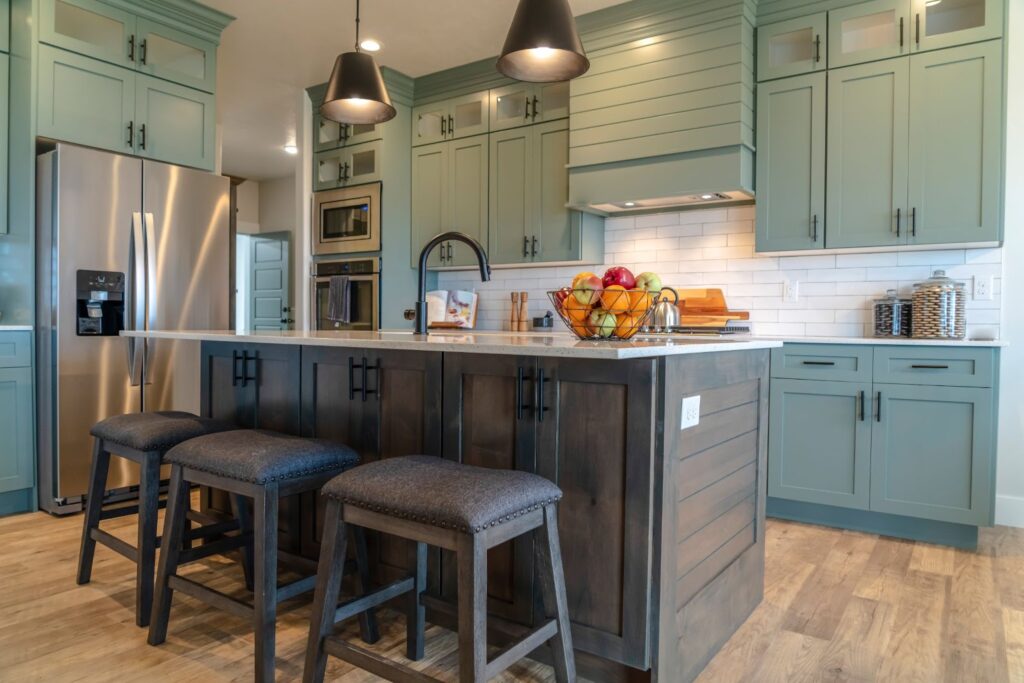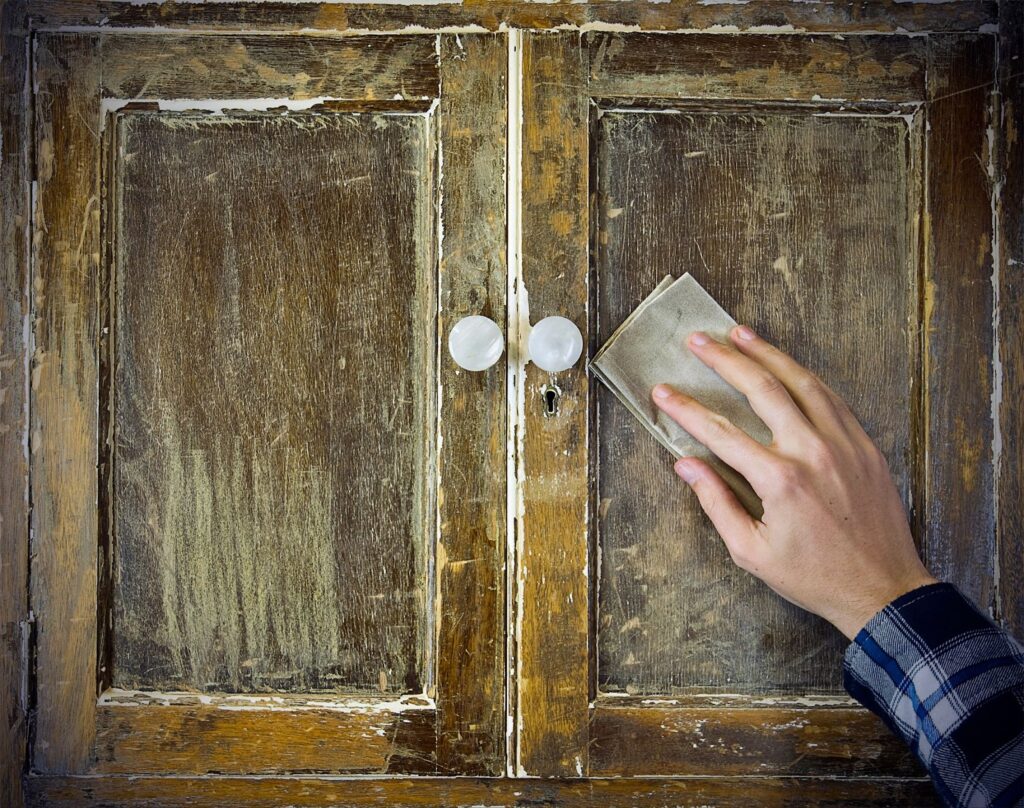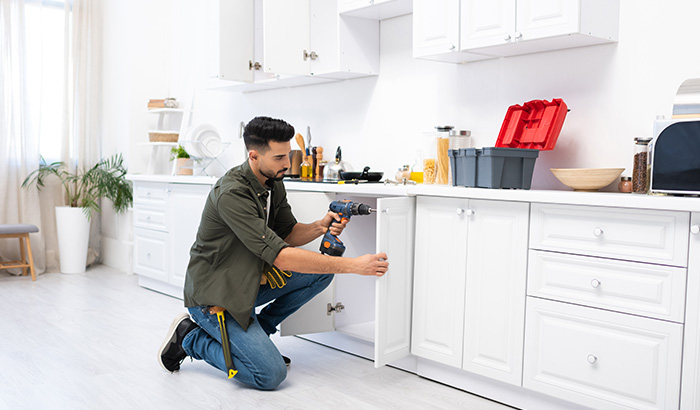There’s a beautiful shift occurring in homes and spaces around the world of restoring old cabinets. As more and more individuals embrace sustainability, upcycling, and the enchantment of yesteryears, restoring cabinets has flourished as more than a fleeting trend.
Restoring vs. Replacing: What’s the Difference?
When kitchen or bathroom cabinets show signs of wear and tear, the immediate thought might be to replace them. Replacement means out with the old and in with the new. It’s buying brand-new cabinets and installing them in place of the old ones, offering a completely fresh look.
In contrast, cabinet restoration is a more thoughtful and eco-conscious approach. It’s about taking what’s already there and reviving it. Instead of discarding the old cabinets, restoration breathes new life into them, maintaining their original charm and character while updating them to better suit present-day needs.
While replacement offers a clean slate, restoring cabinets embraces the old cabinets’ stories, craftsmanship, and individuality, infusing them with a touch of modernity. The choice between the two often boils down to personal preferences, budget, and the value one places on sustainability and history.
So, as we venture further into this guide, let’s explore why restoring old cabinets is more than a trend; it’s a testament to the timeless beauty of the past, meeting the practicality of the present.

Customization and Personalization: Making Old Cabinets Uniquely Yours
Restoring old cabinets is not only about preserving their intrinsic value; it’s also about infusing them with your style. This beautiful fusion allows homeowners to reap the benefits of modern design while basking in the warmth of vintage charm.
A fresh coat of paint in a contemporary shade might uplift the space, or a matte or glossy finish could provide a different feel. Then there’s the hardware — the knobs, handles, and hinges. Swapping them out for more modern or eclectic pieces is an instant game-changer. Updating these elements allows you to seamlessly integrate old cabinets into contemporary decor while maintaining their rich history.
One of the best aspects of restoring old cabinets is integrating modern amenities, like soft-close mechanisms or built-in lighting. Or perhaps retrofitting drawers with organizers for cutlery, spices, or other essentials. These modifications keep the cabinet’s charm, and enhance its functionality, making it perfectly suited to the demands of today’s lifestyles.
While the appeal of vintage cabinets lies in their rich past, there’s ample space for interweaving your personal touches. You’re not only preserving the cabinet’s essence but also continuing its story, enriching its journey with your chapters.

Durability and Longevity: The Time-Tested Strength of Vintage Cabinets
When embracing the old, there’s more to it than merely aesthetic charm. With their rich histories, vintage cabinets often come with a durability that’s hard to match in many of today’s off-the-shelf products.
Here’s why these antique treasures continue to endure and how, with a touch of love and care, your restored cabinets are destined for even more years of service.
In days gone by, cabinet-making was more than a profession — it was an art form where attention to detail and commitment to quality took precedence. Older construction methods prioritized solidity over speed. Traditional joinery techniques, like dovetail or mortise-and-tenon joints, ensured that every connection point was strong and built to resist the pressures of daily use.
This meticulous approach is a significant reason why many vintage cabinets continue to hold strong, even after decades or sometimes centuries of service. Over time, even the most durable cabinets may exhibit signs of wear. However, this doesn’t signify the end of their journey.
Proper restoration will rejuvenate these stalwart storage solutions, giving them a renewed lease on life. Whether by reinforcing weak joints, replacing worn-out hardware, or applying protective finishes, the cabinet restoration process can add many more years to a cabinet’s lifespan.
With the proper techniques and materials, the renewed strength will match or surpass their original robustness.
What Does the Restoration Process Look Like?
Whether you’re a DIY enthusiast or simply keen to understand the process, this overview will shed light on the key stages of cabinet restoration.
1. Pre-Restoration Assessment and Planning
Before diving into the restoration, it’s crucial to take a moment for a thorough assessment. Examine the cabinets closely, noting areas of damage, wear, or any structural concerns.
- Structure: Check for loose joints, wobbly shelves, or any signs of instability.
- Surface: Look for scratches, stains, peeling paint, or areas of discoloration.
- Hardware: Identify any rusty, broken, or missing handles, knobs, and hinges.
With a clear picture of what needs attention, you can plan your restoration effectively, ensuring you address all areas of concern and gather the necessary resources.
2. Gathering the Right Tools and Materials
The right tools make all the difference in ensuring the cabinet restoration process is smooth and successful. Here are some essentials you might need:
- For Cleaning: Soft cloths, mild detergent, and warm water. For tougher grime, consider a wood cleaner or restoration soap.
- For Repairing: Wood filler, sandpaper (various grits), wood glue, clamps.
- For Refinishing: Paint or stain, primer, paintbrushes, sealant, or varnish.
- For Hardware: Screwdrivers, pliers, replacement knobs, handles, or hinges.
Always prioritize quality when choosing materials and tools. It’s an investment that will determine the outcome of your restoration.
3. Step-by-Step Guide to Restoration
- Cleaning: Begin by gently cleaning the cabinets and removing dust, grease, and any old paint residues. This will provide a clean slate and help subsequent treatments adhere better.
- Repairing: Address structural issues next. Fill any cracks or gouges with wood filler, sanding smooth once dry. Reinforce loose joints with wood glue and clamp until set.
- Refinishing: Sand the cabinet surfaces lightly to ensure the paint or stain adheres well. Apply a primer if you’re painting. Follow with your chosen paint or stain, applying in smooth, even strokes. Finish with a protective sealant or varnish to safeguard your handiwork.
- Updating Hardware: Remove old hardware and replace it with your chosen new pieces. If keeping the original hardware, give them a good clean or even a polish before reattaching.
Common Challenges and Solutions
Restoring vintage cabinets is a fulfilling endeavor, though it’s not without its hitches. Embrace each challenge as a chance to learn and grow!
Here’s a brief on common restoration challenges and their practical solutions:
Warped Wood and Damage:
- Issue: Humidity and temperature changes cause wood warping. Chips, cracks, or water damage are also common.
- Solution: Steam and clamp the wood back into shape for minor warping. Wood filler can address small damages, while extensive ones might require replacing the section.
Accumulated Paint or Finish:
- Issue: Many older cabinets have multiple layers of paint or finish.
- Solution: Use eco-friendly paint strippers and sanding. Start with the stripper, then sand for a smooth surface, ready for a new finish.
Aged or Malfunctioning Hardware:
- Issue: Vintage cabinet hardware might be tarnished or dysfunctional.
- Solution: Clean and polish to revive the original pieces. If unfixable, opt for reproduction hardware or new pieces that fit the vintage vibe.
Sourcing Matching Repair Materials:
- Issue: Matching the unique aspects of old cabinets is tricky.
- Solution: Visit reclamation yards or antique stores with a cabinet sample or photo. Alternatively, make a design statement using complementary materials, like a distinct wood for a door, to create a two-tone effect.
Care and Maintenance Post-Restoration: Ensuring Your Cabinets Shine for Years to Come
So, you’ve lovingly restored your vintage cabinets, intertwining history with contemporary style. But the journey doesn’t end here. Proper care and maintenance are vital to ensure that your cabinets remain in pristine condition, telling their story for years to come.
Here’s how you can give them the TLC they deserve.
1. Tips for Keeping Restored Cabinets Looking Their Best
- Regular Dusting: With a soft microfiber cloth, dust your cabinets to maintain their shine and prevent grime buildup.
- Limit Sun Exposure: Shield cabinets from direct sunlight using positioning or window treatments to prevent fading and structural damage.
- Protect Surfaces: Always use coasters or mats when placing liquids or hot items on your cabinets to avoid potential damage.
2. The Importance of Regular Cleaning and Periodic Check-Ups
- Gentle Cleaning: Address spills with a damp cloth, followed by a dry one. Choose mild soaps or wood-specific cleaners over abrasive products to protect the finish.
- Annual Inspection: Annually inspect your cabinet for wear, loose hardware, or structural concerns, ensuring timely fixes to avoid bigger issues later on.
3. Protective Measures Against Potential Damages
- Balance Humidity: With wood’s sensitivity to moisture, utilize dehumidifiers or air conditioners in humid areas, and consider humidifiers in dry zones for an ideal environment.
- Pest Vigilance: Regularly inspect your home for wood pests, especially if introducing vintage pieces.
- Choose Protective Finishes: For high-traffic cabinets, a clear sealant or varnish guards against damage. Select a finish that aligns with your cabinet’s style, whether matte, semi-gloss, or glossy.
- Use with Care: Gentle handling, avoiding shelf overload, and steering clear of scratches will remarkably enhance your cabinet’s lifespan.

DIY vs. Professional Restoration: Weighing Your Options
Choosing between restoring cabinets yourself and hiring professionals is akin to standing at a crossroads, each path offering its own experiences and outcomes. Both options come with distinct advantages and potential pitfalls.
DIY (Do It Yourself)
Advantages:
- Personal Satisfaction: There’s a unique sense of pride and accomplishment that comes from taking on a project with your own two hands, seeing it through from start to finish.
- Cost Savings: Opting for a DIY approach is often more budget-friendly since you only invest in tools and materials, not labor.
- Flexibility: You can work at your own pace, making decisions and adjustments as you go, without the constraints of external schedules or opinions.
Potential Pitfalls:
- Time-Intensive: Especially if it’s your first time, tasks might take longer than anticipated as you navigate the learning curve.
- Risk of Mistakes: Without professional expertise, there’s the possibility of errors that might sometimes be costly or challenging to reverse.
- Limited Tools and Equipment: Professionals often have access to specialized tools and machinery that might not be readily available or practical for a DIY enthusiast to obtain.
Hiring Professionals
Advantages:
- Expertise on Hand: Professionals bring a wealth of experience and knowledge, ensuring that the restoration is done right the first time.
- Efficiency: With their skill set and tools, professionals often complete projects faster and with a level of polish that might be challenging for a novice to achieve.
- Stress Reduction: Handing over the reins means you won’t have to deal with unexpected challenges or the minutiae of the cabinet restoration process. You can sit back and watch the transformation unfold.
Potential Pitfalls:
- Cost: Professional services come at a price that might sometimes exceed your budget, especially for high-end restorers.
- Availability: Depending on their demand, you might have to wait for a slot in their schedule, potentially delaying your restoration plans.
- Less Personal Connection: While the end result will be beautiful, some might feel a bit detached from the process, missing out on the personal journey of restoration.
Whether you opt for DIY or hire professionals, the choice ultimately boils down to what you value most: the hands-on experience and potential savings of doing it yourself or the expertise, convenience, and peace of mind professionals bring to the table. Remember, there’s no right or wrong answer — only what feels right for you, your cabinets, and your home.
Allen Brothers Cabinet Painting: Utah’s Premier Cabinet Painting Company
Restoring old cabinets doesn’t have to break the bank. Allen Brothers Cabinet Painting is your go-to solution for achieving that fresh look without the cost of a full replacement. Trusted for both homes and businesses, we truly transform spaces with our expert touch.
For those in Centerville and Bluffdale, Utah, Allen Brothers Cabinet Painting provides premium painting and refinishing services. Contact Allen Brothers today for a free quote — call or text (801) 231-6428.

